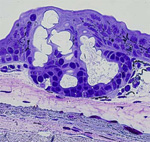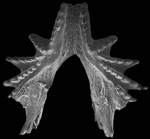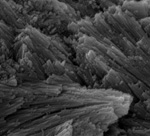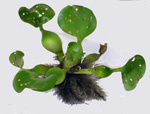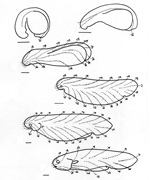

![]()
![]()
![]()
∑ What is a Lungfish
∑ Myths about lungfish
∑ Lungfish are not primitive
∑ Why are lungfish special ?
∑ Survival under adverse conditions
∑ Life cycle of the lungfish![]()
![]()
![]()
Adult lungfish are large fish, mostly brown in colour, with pink bellies. They have big scales covered by slimy skin. They have a wide, flat head, a thick, heavy body and a pointed tail. The paired fins are paddle shaped, and end in points, like the tail. They have small eyes, small mouths, and sense organs all over the head.
Lungfish reach a length of 1.4 metres in the Burnett River, and slightly less in the Brisbane and Mary Rivers. Queenslanders are fond of telling stories about lungfish. One longstanding favourite is that lungfish can leave the water and walk around on the land. This tale was told to Francois de Castelnau, a French diplomat who came to Queensland soon after the lungfish was first discovered. De Castelnau describes the lungfish living in a pond in the gardens of the Queensland Museum, and leaving the water at night to chase frogs on the grass.
People have tried to tell me that lungfish walk around on the river bank, and are quite offended when I point out how weak the fins are, and how they cannot support a heavy fish out of water. A variation of this tale has small lungfish resting on the river bank with their mouths out of water, to be able to breath air. This is not the way lungfish breath air, and they do not need to do this to survive, even when they are small. Another story, told to me by a farmer on the Burnett River, concerns two young Aboriginal lovers. Their friendship did not meet with the approval of the elders, who were chasing them along the river bank. To escape, the pair dived into the river, and was obligingly turned into lungfish by a local deity. The punch line is "and that's why lungfish have human organs". Lungfish are not at all close to humans, and do not tell us more than any other basal fish about human evolution. Lungfish are not primitive. They are well adapted to their natural environment, and are an important part of our biodiversity.
Lungfish are one of many relict species of fish that share basal characters. Others are the coelacanth, which lives in deep waters off the coast of Madagascar and Indonesia, and the bichir, a freshwater fish from Africa. (Fig. 2-03a). Some scientists get excited about lungfish, because they think the lungfish is the closest "relative" of the land animals, including humans. In fact, it has been suggested that amphibians, the first land animals, evolved their limbs from the muscular fins of lungfish. It is true that lungfish have muscular fins, and that they use them to "walk" underwater, with alternating movements, First, one fin moves forward, then the other. The pectoral fins at the front, and the pelvic fins at the back, all work this way. This ability is not confined to lungfish. Many fish can do it, even fish that nobody would describe as a close relation of land animals, such as the bichir, and skates and rays. Other scientists find the idea of a close relationship a little hard to justify because there are so many fossils, the so-called "missing links" that separate lungfish from the amphibians and other land animals. One example of a "missing link" is Tiktaalik roseae, a new fossil fish from North America. This is definitely a fish, but it has fins that resemble limbs. Tiktaalik was found in deposits that are 375 million years old, compared with 410 million years for Uranolophus, the oldest known lungfish. The existence of a fish with limb-like changes in the fins, after the appearance of the earliest lungfish, does not mean that land animals evolved from creatures like lungfish. Nor does it mean that they did not. It means that there are many possibilities, and we do not know the whole story. Obviously, fish and land animals were present, and evolving, long before they appear in the fossil record, so the times of appearance of fossils are not helpful. The truth about lungfish evolution and relationships is a lot less exciting than the media reports about how close they are to human beings. They are fish, and not closely related to humans at all, even if frogs and toads and lizards, and all the other land vertebrates were derived from a lungfish ancestor back in the Devonian, 400 million years ago. It is more likely that they were derived from a different group of early fishes, such as Panderichthys or Tiklaalik. One recent programme on the ABC shows the presenter clutching a living Australian lungfish under one arm while standing in a pool of muddy water. He appears to be holding it rather tightly around the belly and pumping its abdomen with his elbow. The fish is in obvious discomfort, gulping and gasping for air. He uses his other hand to flap the pectoral fin, and assures his audience that the lungfish is 100 million years old and the ancestor of modern land animals because it could breathe in air and water. Not content with this demonstration, he lets the fish go, and repeats the whole event, and the whole dialogue, either with the same fish or another one, squeezing it around the belly and letting the audience see it gasping for air. Far from being a convincing demonstration of how vertebrate animals conquered the land, almost certainly carried out in the early Devonian about 400 million years ago by a different group of early fish, this should be the subject of a complaint to the Royal Society for the Prevention of Cruelty to Animals. Surprisingly, evidence derived from DNA analyses does not provide a final answer to the question of the relationship of lungfish to land animals. The closest lower vertebrate group to the land animals could be the coelacanth, bony fish or lungfish. Occasionally, I have been asked if it is true that lungfish have "human organs" such as a liver and lungs and so on. The short answer to this is a resounding "no". Lungfish are not, in any way, close to human beings. A few years ago, a professor of Biochemistry at the University of Queensland said to me “isn’t it wonderful, what lungfish can do for biomedical research”. It would be, if this were true. Sadly it is totally incorrect. The study of lungfish has only the vaguest relationship to modern medical research, and this is not likely to change. Lungfish are vertebrates, like other fish, and frogs and lizards and birds and rats and people. All vertebrates are built on a similar plan, with brains and livers and hearts and intestines and skeletons and so on. This does not mean that lungfish have "human organs". Lungfish are unusual among fish in having a lung, like the vertebrates that live on land. A lung in a mammal is made up of billions of tiny cavities containing air, known as alveoli. In lungfish, the lung has large air sacs, and no minute alveoli. It works more like the swim bladder of a bony fish than a lung for breathing air. (Fig 2-04) The Queensland lungfish has a good set of gills, and rarely needs to breathe air. (Fig. 2-05,2-06) It uses the lung for air breathing when it is stressed, or needs extra oxygen. (Fig. 2-04). In fact, the “lung” in N. forsteri behaves more like a swim balder, found in many fishes.
Lungfish are good at hiding. (Fig. 2-07) Lungfish match the colours of the environment. Their skins are mostly brown and dull olive with dark patches. Adults may have bright pink bellies in the spawning season, mainly to show off to each other, but this is not visible from above, and is not obvious in the river. Young hatchlings, with their dull colours and mottled skins, are always well hidden in the natural environment. (Fig. 2-08 a, b, c, d)
Lungfish are good at staying out of trouble. Lungfish don't make waves. They live very quietly, so much so that many people who live near the Brisbane River are not aware that there are lungfish so close. They won't often take bait, unless they are very hungry, so there isn't much point in fishing for them with a hook and line. Not many people want to eat them anyway, because they are not tasty. Special sense organs Lungfish have special adaptations to the environment. Lungfish like to be among the weeds and reeds close to the river bank, and within this low visibility environment their eyes are not much use for finding food. They sense the presence of their food animals using electroreception, and mechanical sensors, in the skin of the head and body. (Fig. 2-09, 2-10, 2-11)
Their organ of smell is located in the mouth cavity, and there are taste buds on the tongue and around the teeth. (Fig. 2-12, 2-13)
The organ of smell of a lungfish has nothing to do with breathing. It is used to pick up the scent of other animals in the water. Air does not pass through the organ of smell, when the lungfish draws air into its mouth. The biggest nerves in the lungfish are associated with the sense organs on the head and body. (Fig. 2-14) Rapid escape responses and a flexible skeleton If a predator grabs a little lungfish, the lungfish can twist its body very quickly into a C-shape, and shoot away in an unexpected direction. It can do this because the skeleton is flexible. Lungfish do not have a vertebral column consisting of separate bones working together. Instead, they have retained the notochord, a flexible rod that supports the body and allows the fish to bend. (Fig. 2-15) Notochords are usually found only in vertebrate embryos. The skull of the living Queensland lungfish is mostly made of cartilage, and this protects the brain and sense organs. (Fig. 2-16.)
The cartilage of the skull is covered by thin bones, and the jaws are strong. Permanent, continuously growing teeth Fish have several ways of attaching their teeth to the jaw bones, and most fish can replace their teeth throughout their lives. The teeth may grow in little sockets, or be fixed to a hinge of bone. When the tooth is worn, it is removed and replaced. Lungfish do things differently. They have permanent tooth plates, made up originally of separate teeth, that grow continuously. The tooth plates are attached to the jaw bone because the bone grows up into the tooth. The structure grows and changes shape over the life of the fish, because the bone remodels and grows and more dentine and enamel form around and within the new bone. This attachment is strong, and means that the lungfish can use the teeth hard without risking breakage. (Fig. 2-17) Juvenile teeth are long and sharp, ideal for catching and holding small worms and water fleas. (Fig. 2-18)
The sharp teeth of the young fish change gradually in line with a change in the diet to include plants. (Fig. 2-19) Adults have flat tooth plates for crushing and grinding their food. Their diet includes plants and animals, even water snails with hard shells. (Fig. 2-20)
The teeth have a thin layer of unusual enamel, and a very hard dentine that resists wear. The dentine contains crystals of a mineral called hydroxylapatite. (Fig. 2-21) These are arranged in blocks, or prisms, set at angles to each other, and they prevent the teeth from cracking. (Fig. 2-22)
For lungfish, the dentine is the important part of the teeth, not the enamel. Genes that produce the enamel of lungfish are much the same as the genes that form the enamel of mammal teeth, and a related tissue, enameloid, in shark teeth. Although the genes are conserved, the tissue and material they produce is different. Enamel in mammals is prismatic, with straight, smooth, hexagonal crystals of hydroxylapatite. The enamel of mammalian teeth is as hard as some forms of dentine in a lungfish tooth plate, but this is a physical measurement of hardness, and not related to the way the tissues form in the fish, or to their structure in the adult. Enamel in a mammalian tooth is not otherwise similar to lungfish dentine, or to lungfish enamel. Enamel in lungfish consists of protoprisms, made up of complexes of bent crystals tangled together (Fig 2-22a). Each crystal is exceptionally long and has a rough surface.Survival under adverse conditions
Lungfish, like any other living being, like good clean conditions - clear flowing water, plenty to eat, and places to hide. (Fig. 2-23) They are able to survive under poor conditions, such as during a flood or a dry period, or even in water of low quality. This does not mean that they choose to live in such places. They do not make a cocoon like the African lungfish, which can survive when the water in the lake dries out completely. However, Australian lungfish can survive when their pond dries up if they are covered in damp mud and water plants. Lungfish travelled to London by sea in 1901. They were packed in wooden boxes and wrapped in damp water plants, which were sprinkled with water to keep them moist. Spawning
Lungfish lay eggs annually, between August and December, in response to increasing day length. (Fig. 2-24) Spawning of wild lungfish is not influenced by water temperature, rainfall, oxygen in the water, or the lunar cycle. Lungfish are particular about the area of the river where they lay their eggs, and come back to the same sites every year. Ecologists call this "site fidelity". It is not always obvious why some places are chosen by the fish over other places that appear to human eyes to be similar. It may have something to do with water flow. Under normal conditions, lungfish usually lay eggs close to the shore, and seem to prefer flowing water. If the water level is low, it can look as if lungfish are not particular about where they lay their eggs, because too many pairs are trying to spawn in the same area. It may appear as if the fish are laying eggs everywhere. Many of these eggs end up in unsuitable places, with nowhere for the young fish to hide.
They lay eggs among, or near, water plants or the submerged roots of trees growing on the river bank. (Fig. 2-25) Eggs may be found on many different plants, known as macrophytes, or even on sticks and bits of rubbish. Macrophyte means "big plant", and refers to submerged plants that grow in shallow water along the river bank. Native water plants like Vallisneria spiralis or Hydrilla verticillata are often used (Fig. 2-26, 2-27), but the lungfish prefer the roots of the introduced water hyacinth over any native plant. (Fig 2-28 water hyacinth)
The egg capsule is sticky when it is first laid, and adheres to water plants if they are close. Suitable macrophytes are usually present, because the parents are near these plants while they are spawning. Alternatively, eggs may be shed into the water and caught in the water plants. Eggs that do not become attached to the water plants may be washed into deep water or into a place that is not suitable for young fish. Spawning in the Brisbane River can be affected by water quality, and rapid flow rates in a river may prevent eggs from being attached to the water plants.
Lungfish eggs are about three millimetres in size, and are enclosed in a translucent jelly coat. The egg is green or brown in colour. This is because bile salts with these colours stain the yolk globules. The outer covering of the egg contains a lot of dark pigment, which may be protective against strong sunlight. The newly laid egg is hemispherical, unusual in the fish and amphibian world. As it develops, it takes on a rounded shape. A little fish has formed after about a week, depending on the temperature of the water. At first, it is curled up in a small space within the egg case, and conditions are cramped. As the muscles develop, the young fish wriggles, and makes more space in the egg capsule. Eventually, the inside of the case breaks down, and the little fish is free to move around more. Gradually, the outer egg case expands, and holes appear. The fish is now free to leave the egg case. This takes about three weeks from the time the egg is laid. They live among the plants to which the egg case is attached, and slip back in to the case when danger threatens. Young lungfish look a bit like long thin tadpoles when they hatch, and change gradually until they look like the adult lungfish. There is no sudden transformation, or metamorphosis, as happens when amphibian tadpoles become frogs or toads. Lungfish do not move around much, or begin to feed, until about a month after hatching. Then they live and feed in the macrophyte bed, close to their egg capsule. At early stages in the life cycle, they are extremely vulnerable, and prey for many river animals, such as water birds, insect larvae, other fish, and even their own parents. This is why they need to live in a protected microhabitat, composed of water plants and including the small animals that they use for food. Young fish that come from eggs that are attached to the water plants have the best chance of surviving. Luckily for them, they grow quickly. Most animals cannot hurt adult lungfish. Staying clean with cilia and slime The hatchling habitat among the water plants or roots is not clean. Young lungfish have a special way of staying clean, even before the little fish leaves the egg capsule. Small lungfish have cilia all over the skin, to remove dirt and tiny animals that want to live on them. Cilia are like little hairs growing out of the surface of the cell. They are able to move, and sweep dirt away from the fish. (Fig 2-29) They appear well before the fish is able to hatch (Fig 2-30)
By the time the fish is ready to leave the egg case, the skin has a lot of cells with cilia. (Fig 2-31) In a young free living fish, cells with cilia are all over the skin (Fig 2-32) The cilia move in a pattern and clear the egg case of dirt, or make a space around the little fish (Fig 2-33). They sweep the surface of the fish backwards, up and down.
This is useful to the fish when it is living in the egg case, or sleeping among the leaves of the water plants. As the fish gets older and more active, the cilia disappear, and the skin grows slime glands to keep the surface clean. Adult lungfish are very slimy. Raising lungfish Almost as soon as lungfish eggs were discovered, people tried to raise them. Most of these efforts were unsuccessful. They used the wrong food, or contaminated water, and kept too many fish in one container. Bancroft tried for years to raise lungfish, and eventually hit on a partially successful method. He started to keep eggs in separate containers of clean water, one egg to each dish, covered to prevent evaporation. This meant that if eggs became infected and died, they did not pass on their infection to other eggs, destroying every other egg in a dish. Isolation of eggs is important, but Bancroft was still unable to raise the young for long, because he thought they ate microscopic animals and plants, or would eat an artificial diet. He thought that the little fish needed a slope to rest on with their mouths out of water, and that if they could not breathe air they would die. I used Bancroft's method of isolating eggs, and gave them living food, like black worms or water fleas. This works, provided food is offered as soon as the little fish are ready to feed a few weeks after hatching.
They do not need a slope to rest on so that they can breath air. After the lung develops, the fish rise to the surface when it wants to breathe air, as does the adult (Fig 2 -34, breathing air) The trick to raising lungfish in captivity is separation of the eggs, live food, clean water, clean dishes, and fresh water at regular intervals. Lungfish are a protected species and you need a licence from the Queensland Government if you wish to keep or raise lungfish. Protection for lungfish, under a State Government law, The Fish and Oyster Act of 1914, was initiated by Bancroft, who was the first to realise that lungfish could be at risk if their environment was damaged. Caring for lungfish Adult lungfish eat plants and animals, such as snails, clams, prawns and water plants. Young lungfish eat small animals like worms and water fleas. They do not eat plants until they are older. Wild lungfish are not scavengers, but older fish will eat dried food in captivity. The best way of looking after older fish in captivity involves offering them a suitable mixture of plant and animal food, and regular weekly changes of about one third of the water in the tank, always using conditioned water. They like a sand or gravel substrate, so that they can make little burrows, and should be given somewhere to hide, such as a pipe or a flower pot. |
||||||||||||||||||||||||||||||||||||||||||||||||||||||||||||||||||||||||||||||||||||||||||||||||||||||||||||||||||||||||||||||||||||||||||||||||||||||||||||||||||||||||||||||||||||||||||||||||||||||||||||||||||||||||||||||||||||||||||||||||||||||||||||||||||||||||||||||||||||||||||||||||||||||||||||||||||||||||||||||||||||||||||||||||||||||||||||||||||||||||||||||||||||||||||||||||||||||||||||||||||||||||||||||||||||||||||||||||||||||||||||||||||||||||||||||||||||||||||||||||||||||||||||||||||||||||||||||||||||||||||||||||||||||||||||||||||||||||||||||||||||||||||||||||||||||||||||||||||||||||||||||||||||||||||||||||||||||














